MXA RACE TEST: 2017 HUSQVARNA TC250 — TWO-STROKE TROUBLEMAKER
Click on images to enlarge
Q: SINCE THE KTM 250SX AND HUSQVARNA TC250 ARE SO SIMILAR, IS ONE BETTER THAN THE OTHER?
A: Yes. Even though the engine, chassis (save for the subframe) and suspension are identical, every MXA test rider was adamant that the Husky TC250 handled better, put more usable power to the ground and had a broader, easier-to-use powerband. At first, this doesn’t make much sense, but once you break the two bikes down to their nuts and bolts, you begin to understand what differentiates them.
Q: WHAT ARE THE DIFFERENCES BETWEEN THE HUSQVARNA TC250 AND THE KTM 250SX?
A: At first glance, these machines appear to be twins. Although, as with any set of twins, they each have their own distinct personality and those subtle clues that allow you to tell one twin from another. However, when you look deeper into the mechanical aspects of both bikes, you begin to uncover the differences. Here is a quick list of what distinguishes a TC250 from its brother.
(1) Weight. You would think that identical bikes would weigh the same. They don’t. The Husky carries around some extra baggage due to the plastic subframe and GSX brake rotors, making the TC250 one pound heavier than the 250SX at 212 pounds.
(2) Swingarm. The two competing swingarms share the same overall shape, but a closer look reveals that they are different. The difference between the two is in the cross-section, made evident by the hard line running down the center of the Husky swingarm, while the KTM version is less angular. The TC250’s swingarm starts off with the same thickness as the 250SX’s, then tapers off with a step in the metal. Therefore, the flex characteristics of the two swingarms are different.
(3) Subframe. Husqvarna’s three-piece, carbon fiber-infused subframe is the biggest difference between the two bikes. Compared to the 2016 TC250, the subframe has been significantly downsized, allowing it to shed some weight; however, the same can be said for KTM’s aluminum subframe and plastic airbox combo. Don’t be fooled into believing that Husky’s airbox is made from high-tech carbon fiber. It is a composite of 70-percent plastic and 30-percent carbon fiber particles. Since it bolts together in three segments, it has more resilience at the joints, which makes it less rigid than KTM’s aluminum tubes. Every MXA test rider credits the plastic airbox with giving the rear end of the TC250 a softer feel than the 250SX. The downfall? It is heavier.
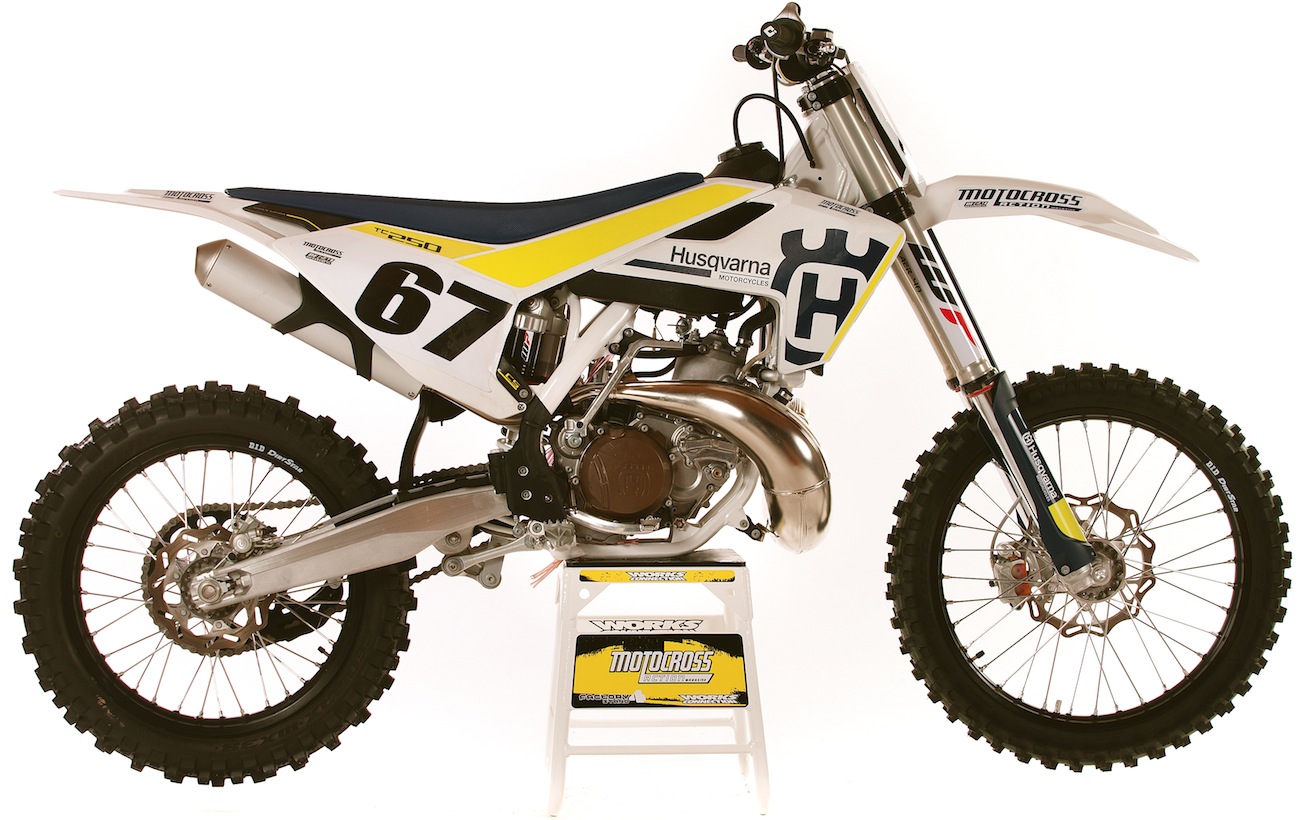
(4) Airbox. As was the case last year and the year before, the Husqvarna airbox restricts the flow of air into the engine. There are no visible air vents. They are hidden inside the hand-holds. The Husqvarna airbox cover is much larger than that of the KTM. In fact, the Husqvarna airbox cover is the complete left-side panel, with the radiator shroud, airbox cover and rear number plate all encompassed in one plastic piece. Because of its large size, it makes the Husky TC250 feel wider than the KTM 250SX. Many testers felt that the extra width made the TC250 easier to grip with their knees.
(5) Seat length. Both the 250SX and TC250 already have long cockpits. The bikes feel flatter and roomier than comparable Japanese bikes. The TC250’s seat is 1-1/2 inches longer than the 250SX’s seat.
(6) Rims. Husqvarna specs D.I.D. DirtStar rims, while KTM uses Takasago Excel rims (although they don’t label them with the Excel logo anymore). For 2017 we have had better luck keeping the spokes tight and the wheels true on the DirtStar rims than on the plain-Jane Excels.
(7) Handlebars. Husky runs Pro Taper bars while KTM runs Nekens. The bars have a similar feel, but the Pro Tapers have a different sweep angle. Some riders felt that they were too low.
(8) Brakes. The Husky GFK front and rear rotors are beefier than the KTM Galfer rotors.
(9) Price. The TC250 is $100 more than the 250SX at $7799.
(10) Clutch. Husqvarna’s clutch is equipped with a Magura clutch lever, master cylinder and slave unit, while the KTM has Brembo components. The Magura clutch has a smoother overall feel, and the lever is an unbreakable folding design with a more petite shape.
(11) Frame guards. The KTM’s black frame guards match its black frame paint. The black Husky frame guards are much shorter because the engineers did not want to cover up too much of the white frame. The price that Husqvarna pays is that the white paint on the frame starts to wear off mighty fast.
(12) Look. All the Husky’s plastic is shaped differently from that of the KTM’s, save for the fork guards.
Q: DOES THE AIRBOX COVER HAVE TO BE DRILLED TO PRODUCE THE SAME POWER AS THE 250SX LIKE BEFORE?
A: To make the Husky TC250’s powerband feel like the KTM 250SX’s powerband, you would need to allow more air into the engine. But, we didn’t drill holes in our TC250 airbox cover. Why not? The powerful new engine runs like a scalded cat. It has a hard midrange hit that is prone to breaking traction in a split second. Additionally, the new engine’s shift points are short, and the power falls off on top very quickly. Bottom line, this potent powerplant makes the KTM 250SX harder to ride, but this is not true of the Husqvarna TC250 powerband. The Husky’s restrictive airbox wouldn’t be a plus on very many bikes, but the side effects of the plastic airbox extend far beyond just the power delivery. Most MXA test riders give it credit for the TC250’s better handling, longer shift points and improved over-rev. That’s what you call turning a sow’s ear into a silk purse.
Q: HOW DOES THE TC250 HANDLE?
A: With the combination of the new chassis and the suspension refinements that Husky made to its 2017 line, the TC250 handles exceptionally well. For 2017 Husky upgraded the entire TC and FC lines to WP AER 48mm forks (drop-kicking the WP 4CS coil spring forks). We not only like the new WP air fork, we love it. Motocrossers are tired of complicated air forks with a zillion clickers and more air chambers than Aquaman. KTM’s AER forks are both an engineering marvel and an idiot’s delight. They make other air forks look like the instrument cluster on a nuclear submarine. Simple is better.
The old frame had a rigid feel that did not allow the bike to settle. It was always doing something that we didn’t want it to do. The new-generation frame works together with all the other components on the bike. It allows the parts to work in unison. It has a forgiving feel that allows the Husky TC250 to conquer any terrain.
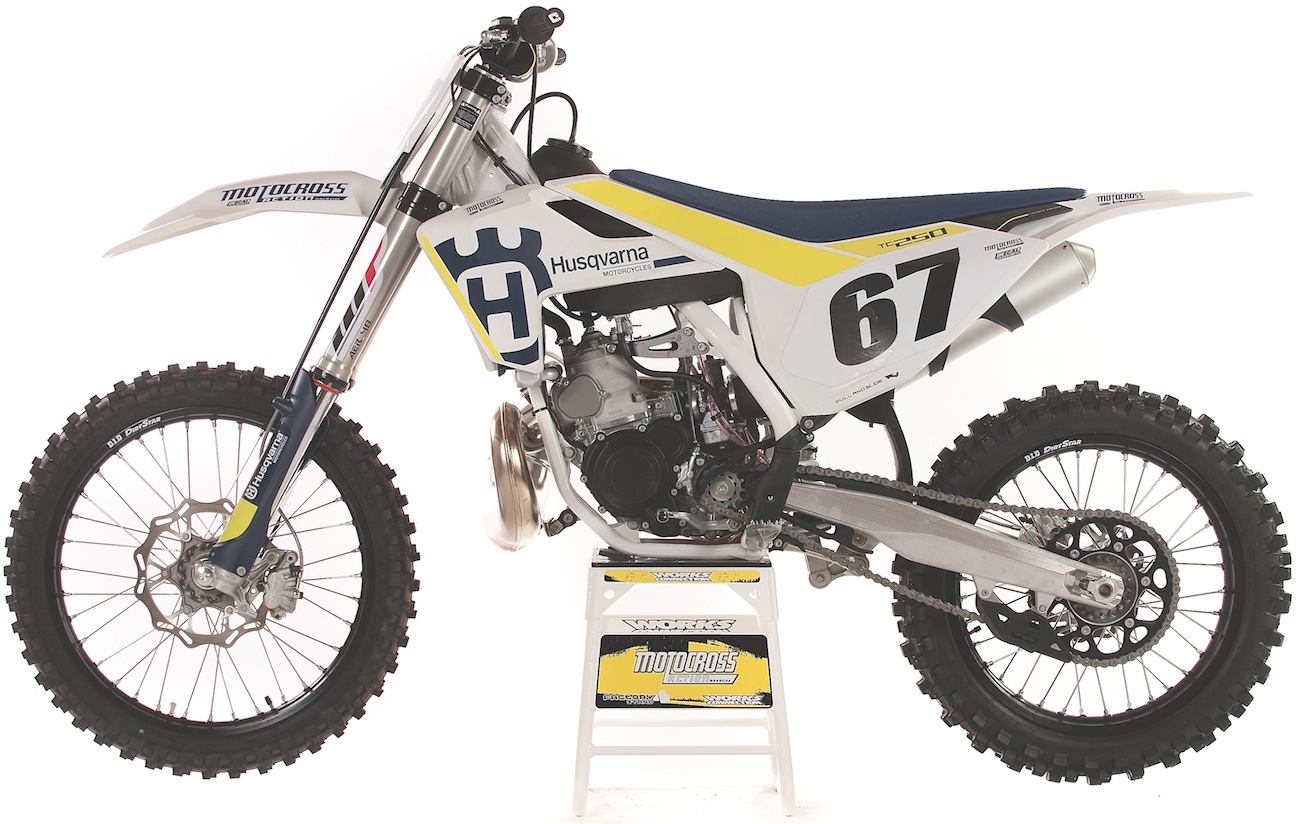
Q: IS THERE STILL A DUAL-FUNCTIONING MAP SWITCH ON THE HANDLEBARS?
A: No. For 2017 Husqvarna decided to do away with the map switch on the TC250—maybe because we never used it in the first place. Although there is no map switch, we did find a trick to mimic the function of using two different maps. Directly under the tank you will find two ends of a gray wire that are plugged into each other by white male and female ends. When these are unplugged, it switches the mapping to a less aggressive map. Most of our testers did not care for it, but there were some who used it all the time (and not just on hardpacked tracks).
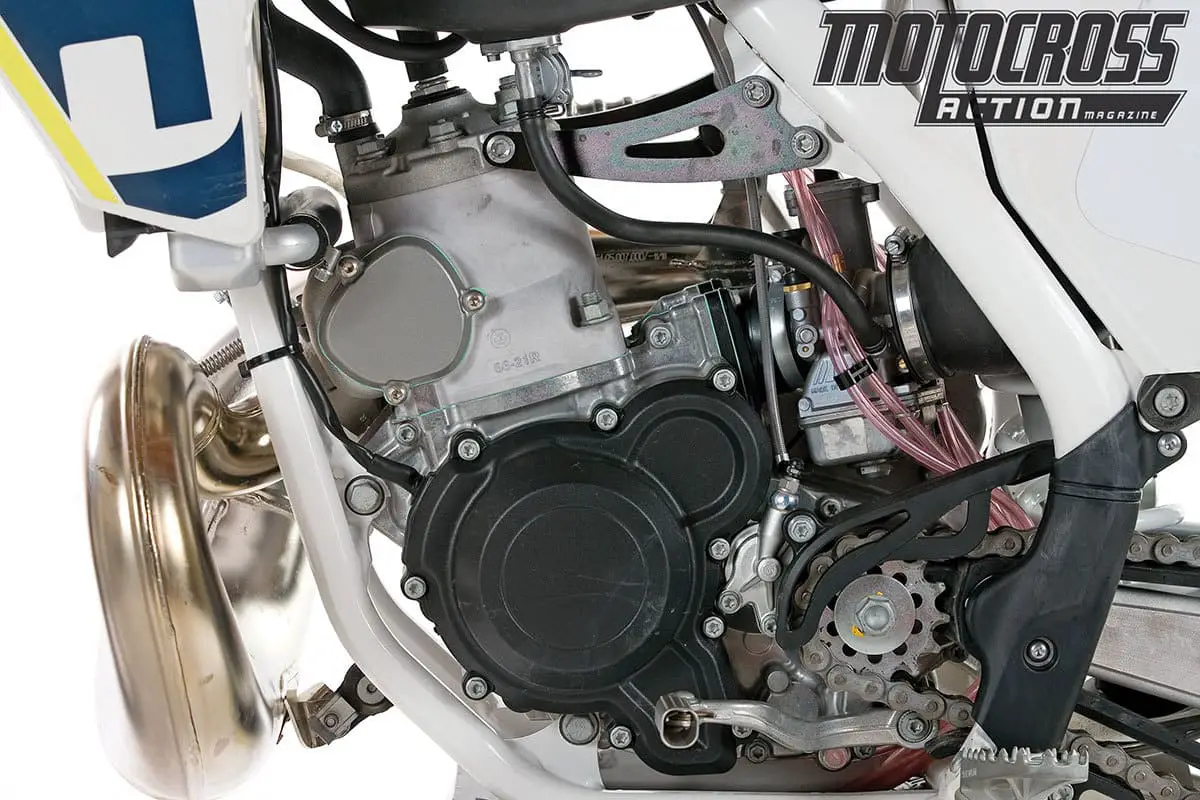
Q: WHAT OTHER CHANGES DID WE MAKE TO THE TC250?
A: We started off with gearing. Although the TC250 pulled further from gear to gear than the KTM 250SX, our testers wanted another 15 feet between shift points. We did this by going down one on the rear sprocket, from a 50 to a 49 tooth. This lengthened the gearbox from gear to gear and smoothed out the powerband. The next thing we did was tone down the power valve.
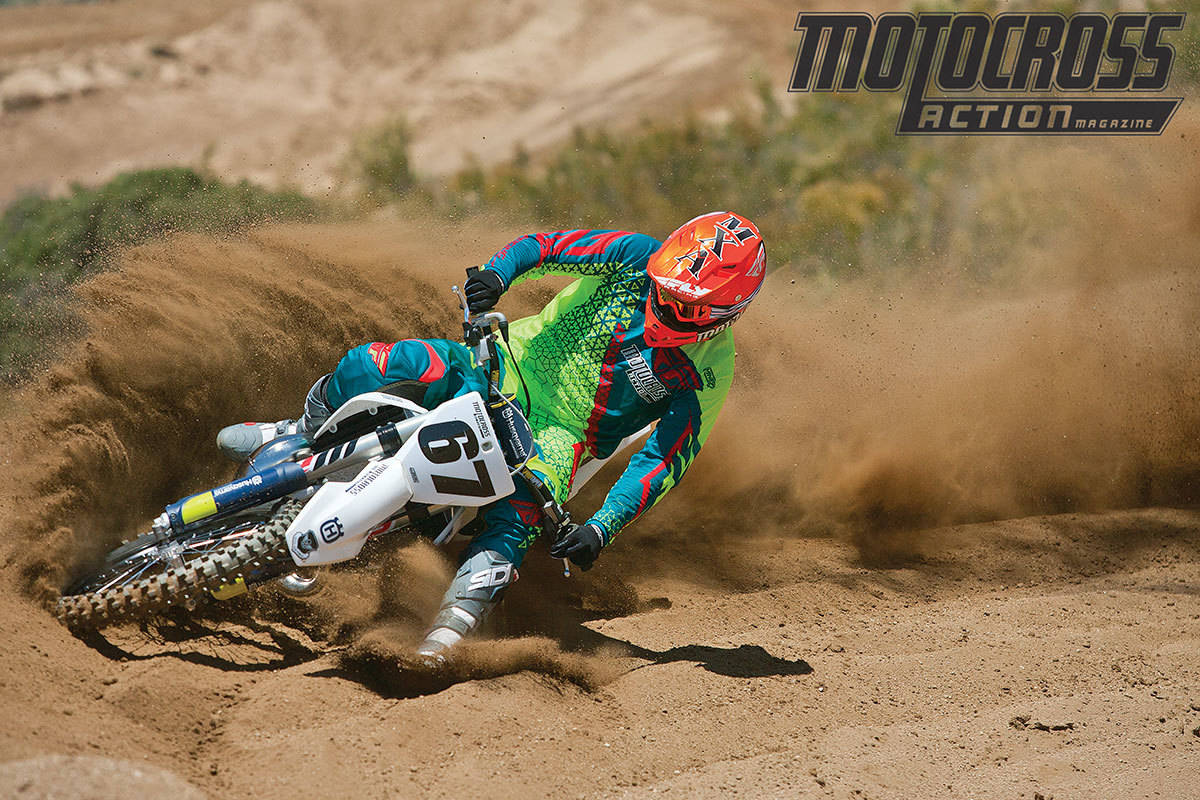
The power valve allows you to change the opening point of the power valve by adjusting the preload on the spring that holds it in the closed position. It is located on the right side of the bike and calls for a square tool to adjust it. We couldn’t find anybody with the odd tool (called a Roberson wrench), so we used a flathead screwdriver that fit diagonally into the square opening. To adjust the TC250 power valve, you don’t have to loosen the two 6mm bolts on both sides of the adjuster. It will turn without touching them. Start by turning the adjuster all the way out—them turn it in. Stock is 1 full turn in (from all the way out). Most MXA test rider preferred to turn it in another turn and a half. However, the best way to set the power valve adjuster is to set it on the stock setting and ride the bike, then turn it in (or out) a 1/4-turn increments and feel the difference. You can feel the shift in power placement as you go. Stop when you like the position of the hit or the smoothness of the delivery. Every track and rider seemed to like their own unique setting. There is no right or wrong, but we went 2-1/2 turns in from all the way out. On the identical KTM 250SX we ran it 2 turns out.
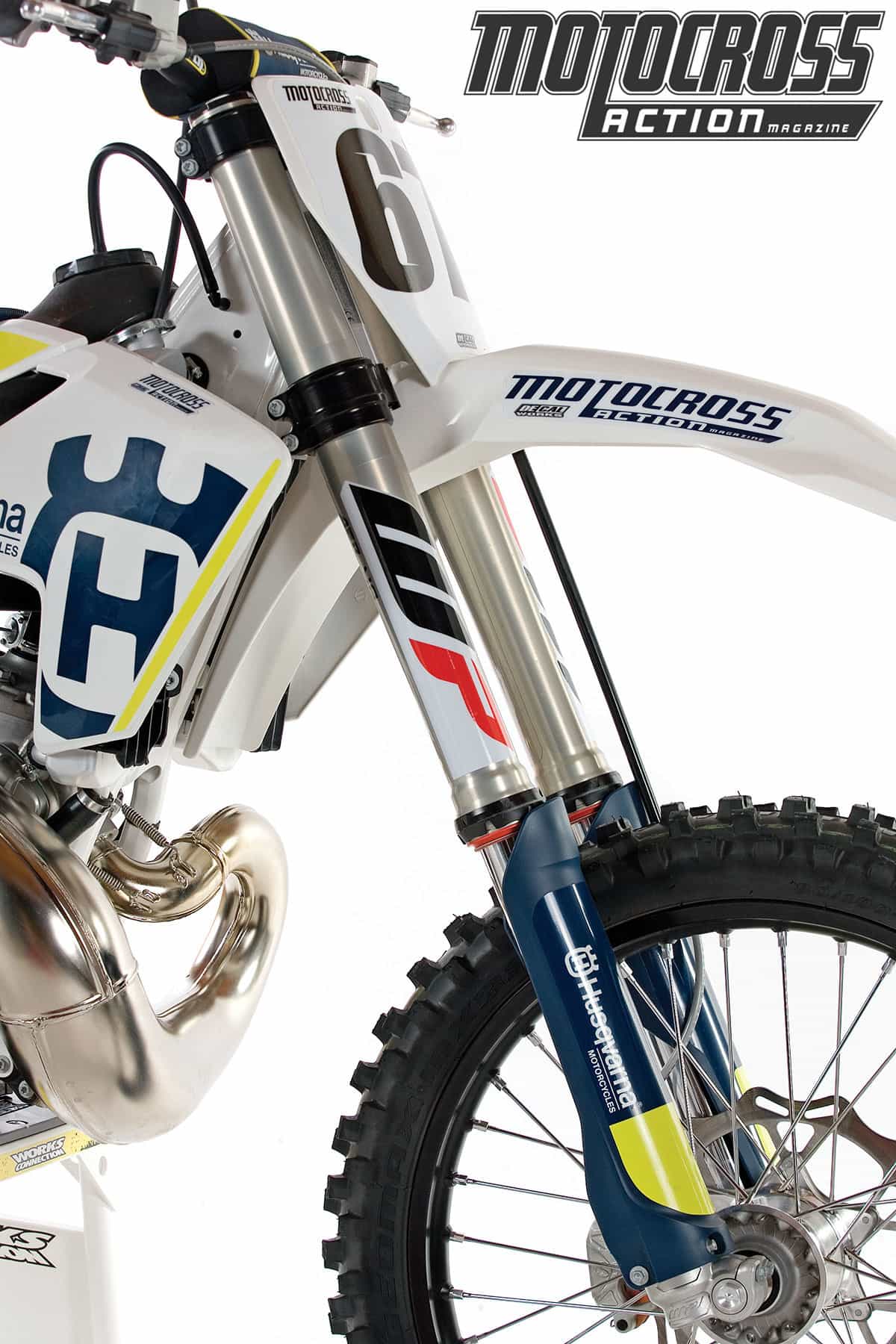
Q: WHAT DID WE HATE?
A: The hate list:
(1) Transmission. The new engine does not fit the power of the old tranny. The ratios are too short from gear to gear, especially from second to third.
(2) Frame guards. With the TC250’s puny frame guards, the white frame is exposed. Thus, after just a few rides, the white paint starts to wear off.
(3) Brake pedal spring. We had issues catching our boot on the brake-pedal spring and disconnecting it. We turned it around and never had the issue again.
(4) Gearing. To mellow the power and lengthen the shift points, we went one tooth down on the rear, from a 50- to a 49-tooth sprocket.
(5) Tubes. Replace the lightweight tubes before you get a flat.
(6) Shock collar. We hate the shock’s nylon preload adjuster and always have. We make preload adjustments by prying on the shock collar while using the frame as a leverage point for a very long flat-bladed screwdriver.
Q: WHAT DID WE LIKE?
A: The like list:
(1) Grips. We love the lock-on ODI grips.
(2) Air filter. Installing an air filter on the TC250 is dummy-proof. It just can’t be messed up, even if you install it backwards.
(3) WP forks. The AER 48 air forks are the best thing since sliced bread. We set the air pressure tothe setting that gets close to full travel and then use the compression clicker to fine tune the feel. Easy, simple and breath of fresh air.
(4) Handling. We love this chassis. This bike goes wherever you want it to with ease. It is nimble, light and corners with precision.
(5) Radiator guards. No need for radiator braces. The stock ones are built for durability.
(6) Sag line. On the rear fender there is a sag line embossed to make it easy to set sag.
(7) Hydraulic clutch. The TC250 got upgraded to the same DDS clutch as the FC450.
(8) Engine. This is a potent engine that has more than enough power across the board.
(9) Map switch. The TC250 does not have a dedicated map switch, but if you feel that the power delivery is too abrupt, you can reach under the gas tank and disconnect the white male/female plug. When this wire is unplugged the mapping goes into the mellow mode. Surprisingly, a reasonable percentage of MXA test riders preferred to race the TC250 with the wire unplugged.

Q: WHAT DO WE REALLY THINK?
A: The 2017 Husqvarna TC250 is a work of art. It is the best 250cc two-stroke to date. It beats the old-dog YZ250 by leaps and bounds, and even its twin brother, the KTM 250SX, has trouble keeping up with it. The Husky TC250 offers what modern two-stroke riders are looking for in a machine. If you’re a two-stroke lover, this is the bike for you.
MXA’S HUSQVARNA TC250 SETUP SPECS
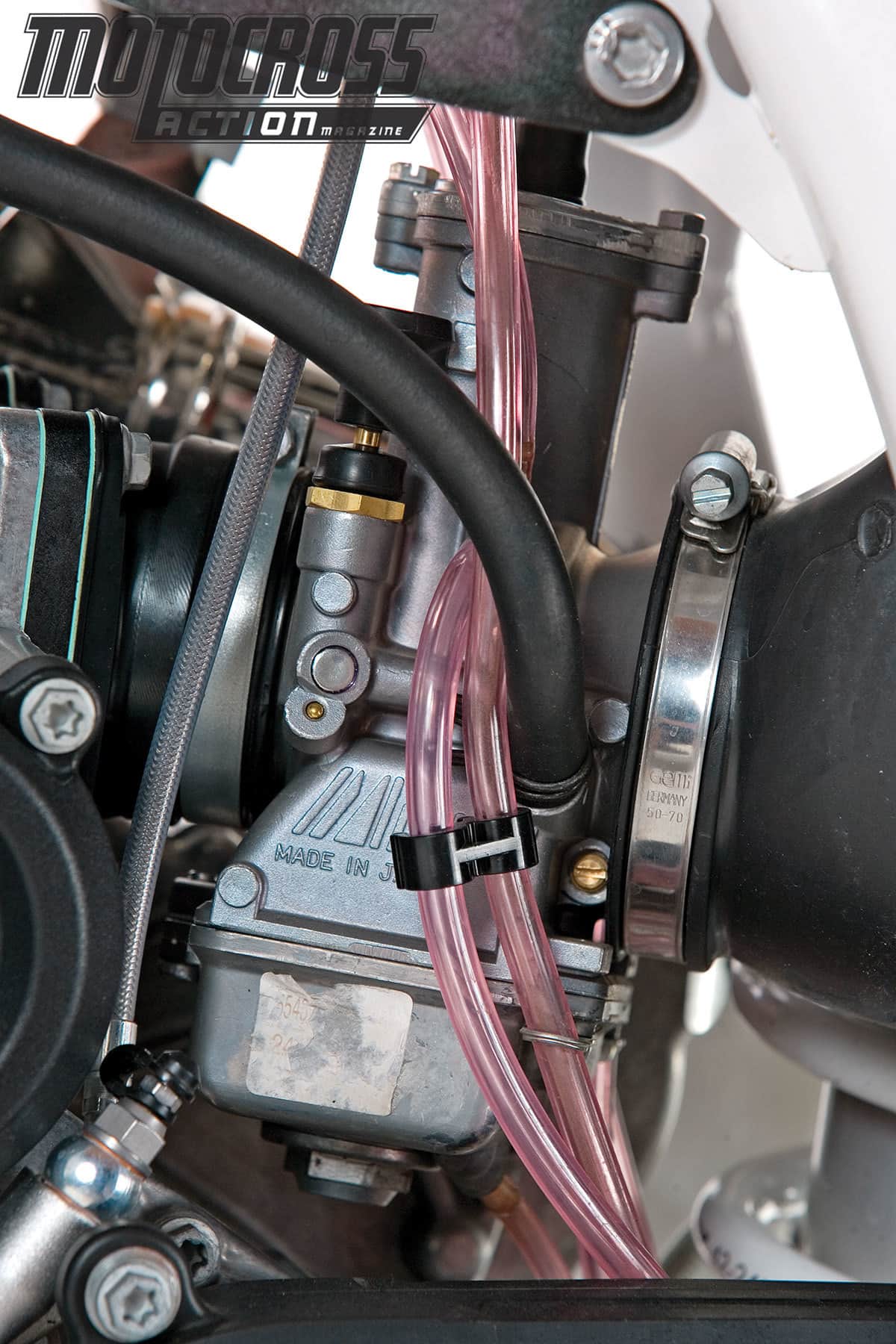
This is how we set up our 2017 Husqvarna TC250 for racing. We offer it as a guide to help you find your own sweet spot.
WP FORK SETTINGS
It was easy to find a happy medium for just about any size rider with the WP AER forks. The recommended 147 psi was in the ballpark for the majority of our testers, although faster riders went as high as 154 and Vet riders found themselves as low as 138 psi. It won’t take long to find your sweet spot compared to the complex Showa triple chamber and Kayaba PS2 forks. For heavier or lighter riders, we adjusted the compression accordingly to allow the forks to ride higher or lower in the stroke. We sped the rebound up a little. Here is what we ran (stock settings in parentheses):
Air pressure: 144 psi
Compression: 23 clicks out (12 clicks out)
Rebound: 19 clicks out (12 clicks out)
Fork-leg height: 2nd line
Notes: On big hits, at pressures below 144 psi, the fork tended to bottom out if the rider was fast or heavy. Anything above 144 psi and our testers had no issues with bottoming resistance. An air pump comes with the bike.
WP SHOCK SETTINGS
There was no need to mess with the shock clickers too much. They were in the ballpark right off the bat. We tried numerous sag settings to balance out the bike. We found 107mm appealed to most test riders. For hard-core racing, we recommend this shock setup for the 2017 Husqvarna TC250 (stock specs are in parentheses):
Spring rate: 4.2 N/m
Hi-compression: 1-1/4 turns out (2 turns out)
Lo-compression: 8 out (15 out)
Rebound: 14 out (15 out)
Race sag: 107mm
Notes: For riders below 185 pounds, start turning out the low-speed compression to get the rear end to settle.
MIKUNI TMX 38 JETTING SPEC
Here’s what we ran in our 38mm Mikuni TMX (stock settings in parentheses):
Main jet: 450 (440)
Pilot: 42.5
Needle: 43-73
Clip: 3rd
Air screw: 2.5 turns out (1 turn)
MXA’S FIRST RIDE! 2017 HUSQVARNA TC250 TWO-STROKE


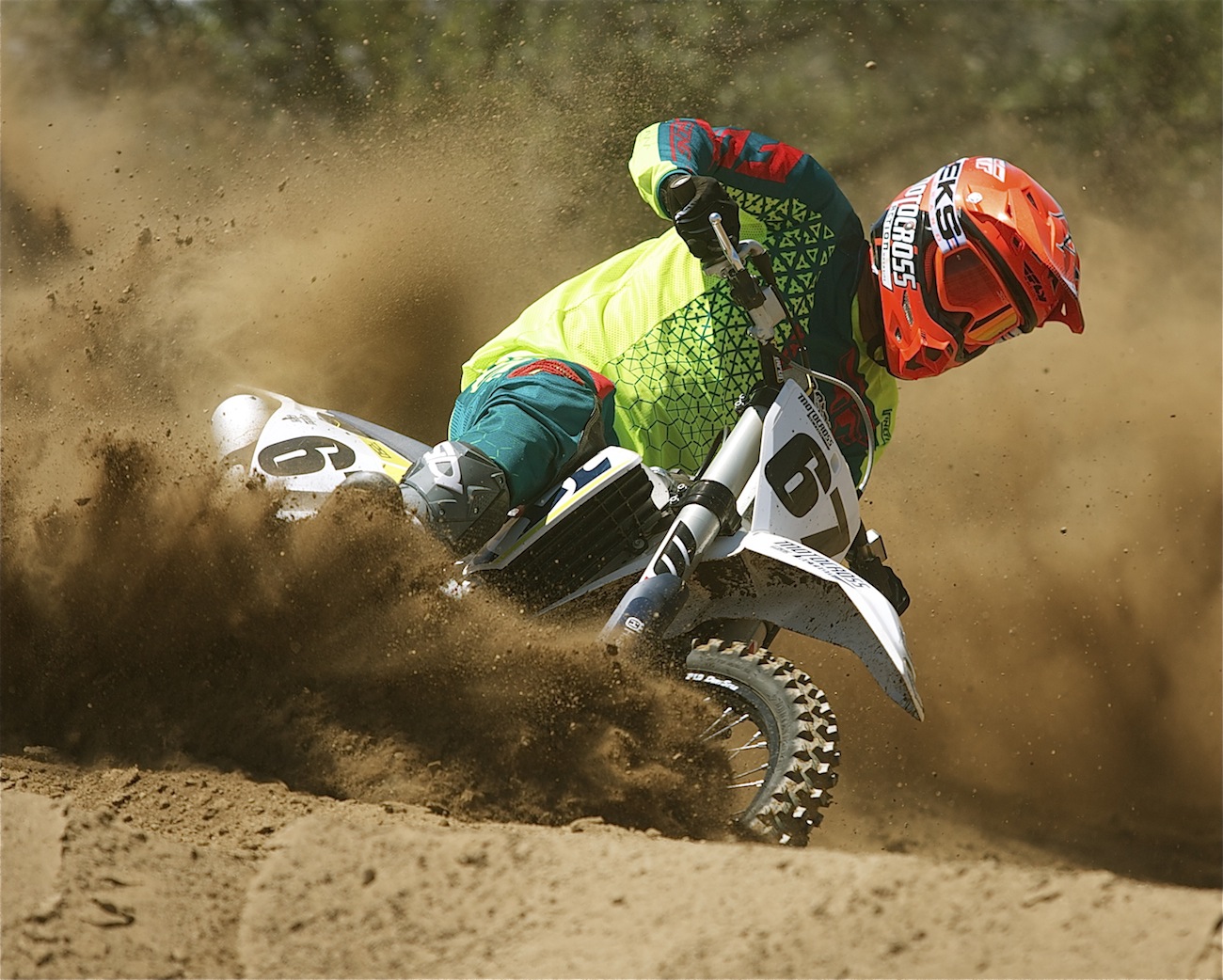

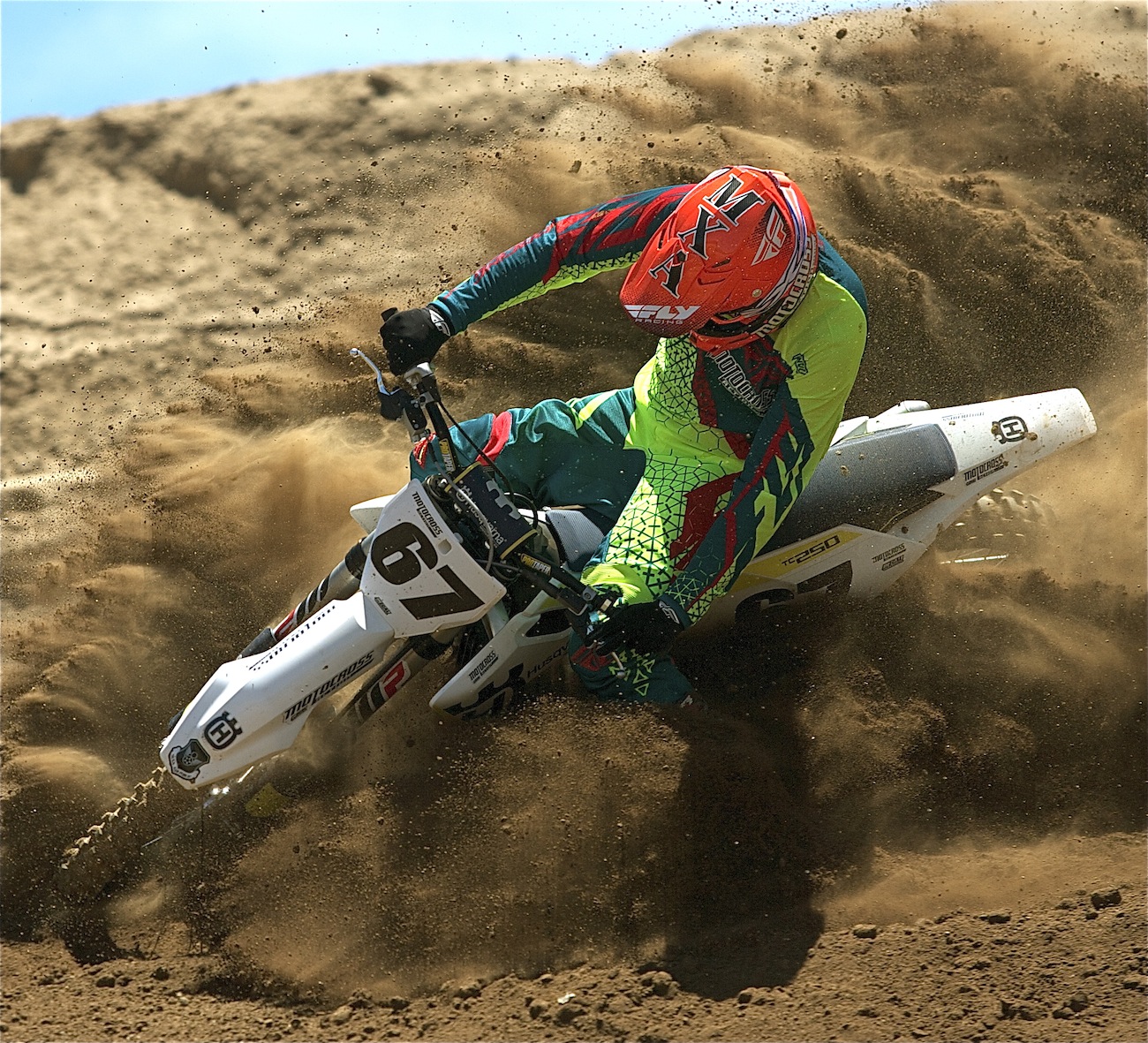






Comments are closed.